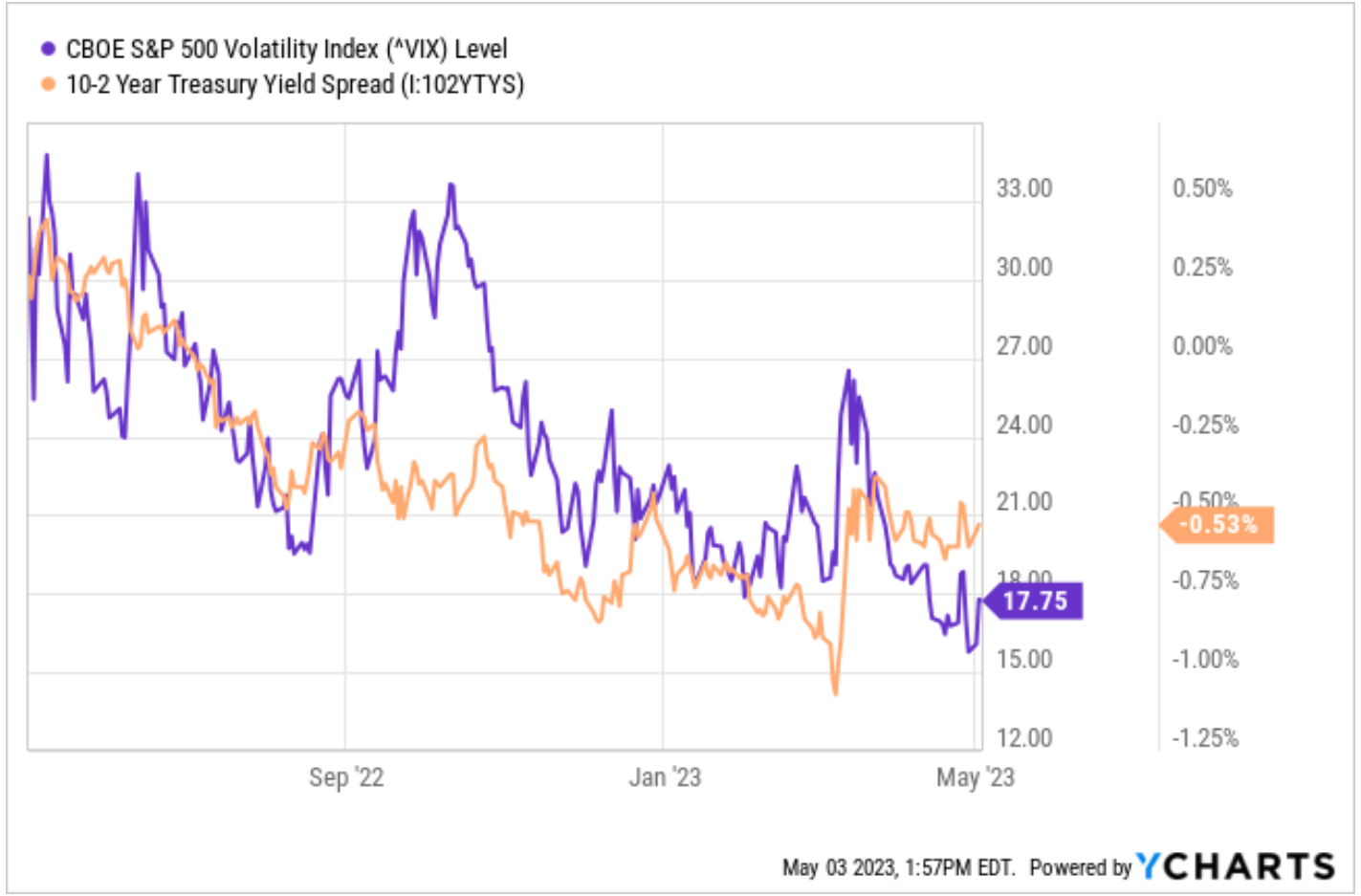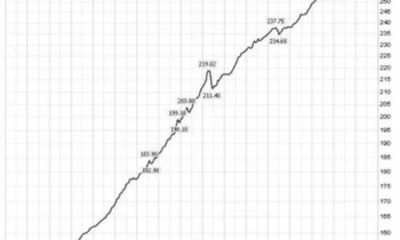Economics
When the Volatility Index Perplexes
“Jim, why is the VIX acting so weird?” That was a question I fielded during one of my talks at last week’s Las Vegas MoneyShow. It’s a great question,…

“Jim, why is the VIX acting so weird?”
That was a question I fielded during one of my talks at last week’s Las Vegas MoneyShow. It’s a great question, and one that I’ve been writing about frequently over the past 12 months. In fact, the day I took that question also happened to be the day we did an update on the CBOE Volatility Index, or VIX, in my Eagle Eye Opener daily market briefing, which, if you haven’t subscribed to yet, what are you waiting for?
The reason this topic has come up recently is because certain dynamics of the typically inverse relationship between the market’s “fear gauge” and the S&P 500 have changed. In the early innings of the 2022 bear market, the “lower lows” in the S&P 500 were no longer coinciding with “higher highs” in the VIX.
Lower stock prices and a higher VIX is a relationship that is typical in bull markets, as hedging activity picks up meaningfully when stocks are driven lower by short-selling speculators (typically these are short-lived, headline-driven pullbacks, hence the use of options as a hedge and not liquidation by institutional money).
The most logical reason behind the change in market dynamics in early 2022 was that institutional investors, who typically employ more sophisticated hedging strategies that include options, started selling their long-time horizon equity holdings and simultaneously began to abandon their associated hedges as they were no longer needed.
As a refresher, the VIX is calculated with inputs from options prices on the S&P 500, so ceteris paribus, more bids in the options market would mean a higher VIX, while more supply, or offers in the options markets, would mean a lower VIX. The institutional selling of options hedges was most likely responsible for the sluggish price action in the widely followed, but often misunderstood, VIX in 2022.
Last week, the VIX fell to its lowest levels since the S&P 500 hit its standing all-time high in the early days of 2022 (just over 4,818). So, with the help of my partner in the Eagle Eye Opener, we took a dive back into history to further analyze how the VIX performed in market conditions similar to today. Here is what we found:

The single, most-dominant market dynamic right now is the deeply inverted yield curve, so, we looked back to periods in history when the yield curve was inverted, the economy was on the brink of, or actually in, a recession and stocks were either in, or falling into, a bear market. Since the VIX was first published in real time in 1993, we are only left with three examples to work with, but the findings are importantly consistent over all three.
In early 2000, the 10s-2s yield curve spread inverted, and later that year, stocks began to meaningfully rollover as the dot-com bubble began to burst. The VIX was volatile over this period but importantly hit 52-week lows in March 2002, just like we saw this VIX do last week. It wasn’t until the VIX became “overbought” on the weekly time frame, via an RSI reading over 70 in July 2002, that the S&P 500 began the bottoming process, putting in cycle lows later that year.
In early 2005, the 10s-2s again inverted, and it remained in backwardation through early 2007. In late 2006, the VIX hit a fresh 52-week low. In the following quarters, the VIX became “overbought” twice on the weekly time frame, the first time in summer 2007 when stocks were near the record highs, and the second in late 2008, just months before the market found a bottom from the turmoil in March 2009.
The 10s-2s briefly inverted in 2019 ahead of the short-lived, but historically deep, Covid-19 pandemic recession. In November 2019, the VIX closed at a new 52-week low. The VIX became overbought in January on its way to new highs, and again in March as the stock market was on the brink of putting in a bottom for the historic year that was 2020.
Today, we are looking at the yield curve hovering just above its deepest inversion since the early 1980s, while the VIX is sitting near 52-week lows, and obviously nowhere near overbought levels on the weekly time frame, a development that preceded all three of the major market bottoms in the “VIX era” of market history.
That suggests we remain in a “calm before the storm” holding period, and until we see the VIX reach overbought territory on the weekly chart (via the RSI indicator), among multiple other developments of course, it will be hard to believe the market is poised to casually cruise towards new record highs from here (i.e., the bottom of this bear market might not be in just yet).
If you’d like this kind of analysis delivered to your inbox every trading day before the market opens — and for about the cost of your morning cup of coffee — I invite you to check out my Eagle Eye Opener today!
***************************************************************
Let Me Slip Away on You
Carefree highway
Let me slip away on you
Carefree highway
You’ve seen better days
The morning after blues
From my head down to my shoes
Carefree highway
Let me slip away, slip away on you…
— Gordon Lightfoot, “Carefree Highway”
On Monday night, the world lost a fantastic singer/songwriter, and a man with a penchant for lyrical storytelling that was elite status. Gordon Meredith Lightfoot Jr. was responsible for many big hits of the 1970s, and if you grew up in that era like I did, you are likely well aware of his work. I had the privilege of seeing Gordon Lightfoot play live, and also of meeting him after that show, about five years ago when he toured in Southern California.
Lightfoot was almost 80 years old then, and while his voice didn’t quite have the beautiful baritone timber of his youth, he still played and sang many of his biggest hits with the virtuoso emotion that he brought to every song. So, for all of the smiles and pensive moments he inspired in me and the countless fans in his six-decade career, I want to wish Gordon Lightfoot a beautiful trip into the carefree highway. And tonight, as I did last night, I will once again toast his genius as I “slip away on you.”
Wisdom about money, investing and life can be found anywhere. If you have a good quote that you’d like me to share with your fellow readers, send it to me, along with any comments, questions and suggestions you have about my newsletters, seminars or anything else. Click here to ask Jim.
IMPORTANT ANNOUNCEMENT: We are having our Eagle Virtual Trading Event on Tuesday, May 16. If you haven’t signed up for this yet, there’s still time. Just click here now to sign up for free. Believe me, you won’t want to miss this online event — as we bring together all of Eagle’s investment experts at the same time to reveal the Second Half Outlook: 7 Ways to Beat the Market. Reserve your seat now by clicking here.
In the name of the best within us,
Jim Woods
The post When the Volatility Index Perplexes appeared first on Stock Investor.

Argentina Is One of the Most Regulated Countries in the World
In the coming days and weeks, we can expect further, far‐reaching reform proposals that will go through the Argentine congress.
Crypto, Crude, & Crap Stocks Rally As Yield Curve Steepens, Rate-Cut Hopes Soar
Crypto, Crude, & Crap Stocks Rally As Yield Curve Steepens, Rate-Cut Hopes Soar
A weird week of macro data – strong jobless claims but…
Fed Pivot: A Blend of Confidence and Folly
Fed Pivot: Charting a New Course in Economic Strategy Dec 22, 2023 Introduction In the dynamic world of economics, the Federal Reserve, the central bank…



















